VAMEDIES: What Do We Owe to Where We May, or May Not, Go?
Who can forget coming across that delicious Friday fish fry outside Beauford, on the way to the Ocracoke Island ferry?
This essence of Vamoserendipity long past floated back across the brain pan amid recent media coverage of Hurricane Florence’s destruction, wherein the Outer Banks and much of coastal North Carolina inward were all but washing away.
What will become of such suddenly pummeled villages and businesses in storm’s wake? How and when will the climate stricken Hatteras region recover, if at all? What role should we play in aiding Flo’s victims in 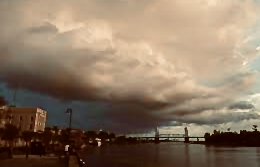 rebuilding a traveler-magnetic destination? Where we have often relished watching the sun rise and set over far calmer waters, Atlantic Ocean to Pamlico Sound, much less other primo destinations and experiences we might wish to re-/discover somewhere in the not too distant future?
rebuilding a traveler-magnetic destination? Where we have often relished watching the sun rise and set over far calmer waters, Atlantic Ocean to Pamlico Sound, much less other primo destinations and experiences we might wish to re-/discover somewhere in the not too distant future?
Carolinas and Coastlines on the Mind.
These concerns were only heightened with news that another, even more powerful storm system was once again drenching the Carolinas this past weekend. Sadly however, this devastation happens to be but part of a broader disaster picture nation- and worldwide.
For the latest Carolina flooding was essentially the tail end of Hurricane Michael, which had just reduced a wide swath of the Florida Panhandle’s beach communities to ground leveled rubble. Category 4 to nearly 5, the tropical storm had been gaining epic force across the Caribbean, hitting shore with winds of up to 155 m.p.h., taking some 30 lives and counting in its sweeping path inland.
By now, stunning video and photos have documented the overwhelmingly lethal power of this historic 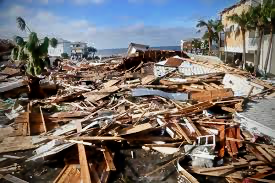 storm—one of the worst the U.S. has ever seen–the very worst slamming the Panhandle since records began in 1851. King tides and sea surges upwards of 8-13 feet engulfed the coastline, one-two punching with its winds to carve a 200-mile corridor of ruin, raging across six states.
storm—one of the worst the U.S. has ever seen–the very worst slamming the Panhandle since records began in 1851. King tides and sea surges upwards of 8-13 feet engulfed the coastline, one-two punching with its winds to carve a 200-mile corridor of ruin, raging across six states.
From Apalachicola west nearly to Pensacola, Hurricane Michael made landfall with shearing winds and torrential rains that snapped pine and cypress trees, flattened structures and flooded entire beachfront neighborhoods. Power and phone lines whiplashed down, lights and communications were and remain unavailable to darkened towns, stranding visitors and residents alike on the roofs of displaced buildings, dodging floating boats and appliances, trapped in heaped mounds of household debris.
Getting a Handle on Hardship.
Some of the hardest slammed towns along the Emerald to Forgotten Coasts are (or were) tourist-dependent beaches and gulf fishing piers/docks: Local independent souvenir, bait and surf shops promoting good, affordable vacations.
Communities like Panama City, Destin and Port St. Lucie caught the brunt of this ‘monster’ storm, as had upper scale Seaside and Alys Beach. Mexico Beach in particular has been all but erased—power/access cut off, at least three-quarters of is homes and businesses reduced to rubble and concrete slabs. 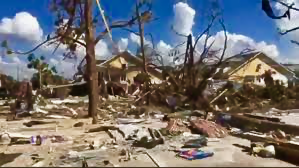
With Panhandle search-and-rescue efforts among shredded homes, felled trees and crushed or overturned vehicles and boats already shifting to secondary searches/recovery mode, Michael pushed northeastward with a vengeance. Throttled to a tropical storm, the ravaging system blew through Georgia at speeds of 12-15 m.p.h., drenching the Atlantic Coast up to Virginia.
But the drizzle-to-gushing rains doubled down on the Carolinas, which still faced ‘100-year’ soil saturation and flash flooding in the aftermath of Hurricanes Florence and Matthew—Outer Banks and Myrtle Beach to rural inland flood plains—not least the waterlogged fish fries of Beauford and New Bern.
Because and Affects.
Whatever the specific causes, tropical storm activity in the Atlantic and Caribbean has only intensified in recent years, especially plaguing the Gulf of Mexico, all the way westward to vastly toxic Hurricane Harvey in Houston.
Global warming creates rising, warmer water, providing the ingredients and energy to feed more powerful, frequent hurricanes, typhoons and cyclones the world over. Warmer air holds more moisture; lower barometric pressure and the temperature spread between the oceans and upper atmosphere form a ‘hot house’ for monster storms such as Michael. Coastlines we cherish and flock to become ever more vulnerable to inundation and erosion. Faster moving storms born of extreme tropical depressions generate higher, stronger life-threatening sea surges, what with water in effect piling up, massively flooding developed shorelines, affluent on down.
Piling up as well are the Panhandle’s economic costs. Beyond the human tragedies, the utter food and 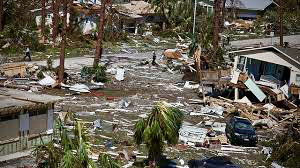 shelter insecurities, insurer losses are topping $10B and climbing, extending to beachfront vacation and real estate industry hits. Inland, cotton, peanut crops, etc. are being devastated, Florida northward.
shelter insecurities, insurer losses are topping $10B and climbing, extending to beachfront vacation and real estate industry hits. Inland, cotton, peanut crops, etc. are being devastated, Florida northward.
Panhandle visitors bureaus claim that stricken communities will bounce back quicker and stronger than ever from this worst storm ever. Still, some municipal authorities note that it may take a year or more to rebuild in Michael’s wake, and gauging damage per its Waffle House Index, FEMA administrator Brock Long admits that this is what a disaster looks like and “it may be a long time before they get back”.
A World Blown Away.
Yet such catastrophes are certainly not unique to the southeastern U.S.. Just ask Hawaiian Islanders who suffered through the August ’18 drubbing from category 4 Hurricane Lane. While Puerto Rico is still staggering from disastrous Hurricane Maria one year on.
More broadly, we witness unprecedented flash flooding in Majorca and the south of France. The strongest typhoon (Jebi) in 25 years just flooded Japan’s main island, sustained winds of 100 m.p.h. killing 11, closing major airports. Worse, Indonesia continues to reel from a 7.5 earthquake and deadly tsunami—particularly the Sulawesi Island villages of Sigi and Palu. Meanwhile, the Philippine island of Luzon is doused by the torrential rains of Typhoon Mangkhut.
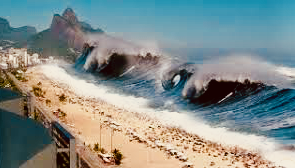 This doesn’t even begin to reckon with the man-made destruction of a Brazilian museum torching, the ‘Great Pacific Garbage Patch’ and various other atrocities worldwide…
This doesn’t even begin to reckon with the man-made destruction of a Brazilian museum torching, the ‘Great Pacific Garbage Patch’ and various other atrocities worldwide…
Ownership Ahoy?
Even if this somehow isn’t all our ozone/carbon doing, the Earth remains our world, the only one we have these days. Moreover, even in the event we might not plan to directly visit disaster zones such as these, what can we do to stem obliteration of destinations we might someday seek out after all? Do we owe them that much, seeing as how such misfortunes could befall us Vamigrés anywhere, at any time? 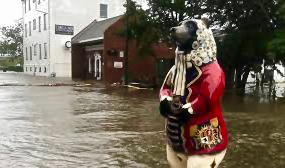
So let’s get to work on this, shall we—whether that means via visitation, Vammiseration, Vamelioration, or direct Vamitigation and/or Vamediation, short or longer term: you get the idea. For in this climate, there will surely be more than enough battered fish to fry down the road…
